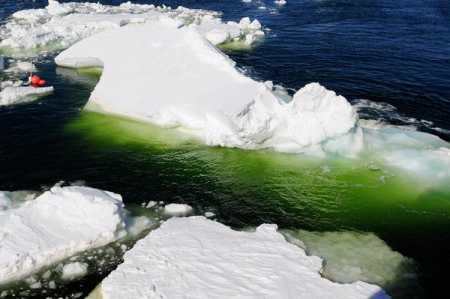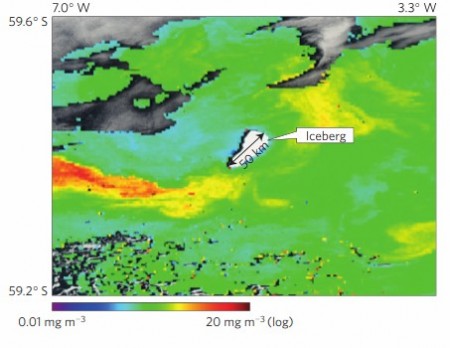January 14, 2016 – Can a melting iceberg keep the planet cooler?
“Absolutely” state University of Sheffield scientists who have been studying the melting of giant icebergs in the Southern Ocean off Antarctica. In the January 11, 2016 issue of Nature Geoscience, authors Luis Duprat, Grant Bigg and David Wilton have written a report entitled, Enhanced Southern Ocean Marine Productivity Due to Fertilization by Giant Icebergs. In this paper, they describe the Southern Ocean as a significant carbon sink contributing approximately 10% of the ocean’s total carbon sequestration. The principal contributors to this carbon sink appear to be giant icebergs that break off ice shelves surrounding Antarctica. Winds carry atmospheric dust to the southern continent and its icy perimeter. The dust eventually gets trapped in the ice and when it makes its way to the ocean via giant Antarctic icebergs the dust begins to do its magic.
The satellite image below, taken in January 2013 shows a giant iceberg, C16, more than 50 kilometers (31 miles) in length. And spreading to the southwest and northeast of the berg are two enormous algae blooms. False colour images show clouds as gray.
This is just one of 175 satellite images taken between 2003 to 2013 that researchers studied that show icebergs associated with significant phytoplankton blooms. Seen in true colour the water surrounding these bergs turns a greenish hue. That colour change which you can see in the image below comes from algae. The full extent of the blooms in the study measured up to four times the iceberg’s length and persisted for as much as a month after the bergs, some measuring 50 kilometers or greater in length, drifted away.
What triggers these blooms of phytoplankton?
The researchers point to the dust. It contains iron which fertilizes the algae.
A few gung-ho advocates of geoengineering have artificially tried to do what these giant icebergs do naturally. In October 2012 I described one of these experiments.
Russ George, an American entrepreneur, decided to seed the Northeast Pacific Ocean with iron sulfate. He dumped 100 tons of the stuff off Canada’s west coast. He believed that iron seeding was an effective way to geo-engineer climate change by turning the ocean into a more effective carbon sink. What he produced was a 10,000 square kilometer (3,861 square mile) algae bloom which lingered for several weeks.
George wasn’t alone in tinkering with the ocean’s natural carbon sink properties. He was following on earlier iron-seeding experiments done by European scientists dating back to 2004. These experiments targeted the Southern Ocean and the research concluded that about 10% of global carbon emissions could come from ocean iron seeding.
The evidence from Southern Ocean icebergs and human iron-seeding experiments, therefore, suggests that there may be counterweights, both natural and artificial, that could reduce the greenhouse gas effect of out-gassing CO2 from human activity. And when you consider that calving of bergs off Antarctic ice shelves should increase as atmospheric CO2 levels rise, the University of Sheffield research team’s observations may become far more frequent in the decades to come. That means an increasing role for the ocean’s biology and chemistry in controlling climate change. In fact, in their conclusions, the University of Sheffield researchers write that melting bergs could contribute as much as 20% of the carbon that gets sequestered by the Southern Ocean. And as the bergs contribute to CO2 reductions they, themselves, may not melt as fast producing interesting oscillations between melting and cooling.
In other studies related to the oceans and their impact on climate change, we have results that suggest melting ice may not perform the same way everywhere. In the North Atlantic, melting Greenland glaciers are emptying into the local ocean at a faster rate than historically observed. The cold meltwater is overriding warmer ocean water and producing local atmospheric cooling.
So do we need to iron seed the North Atlantic? Nature may have provided the answer. When the Icelandic volcano, Eyjafjallajökull, erupted for five weeks in 2010 it produced megatons of volcanic ash containing iron. Much of the ash ended up in the ocean.
Did it lead to reduced CO2 levels and significant algae blooms?
Not for long according to researchers who published their observations in the journal Geophysical Research Letters. The end results are described as “short-lived.” Turns out the extra iron depleted biological nitrates in the surrounding ocean depriving the phytoplankton of nitrogen. So no big algae bloom and as a result, no enhanced ocean carbon sink.
If a volcano produces short-lived results and chemical changes that counter the so-called benefits of iron seeding, what kind of human effort would be needed globally to impact CO2 atmospheric levels and what unforeseen consequences could possibly ensue from such experiments?
We still have a lot to learn to figure out nature’s role in balancing the planet’s carbon cycle. Certainly, no one until this University of Sheffield study had looked at the role icebergs play.










